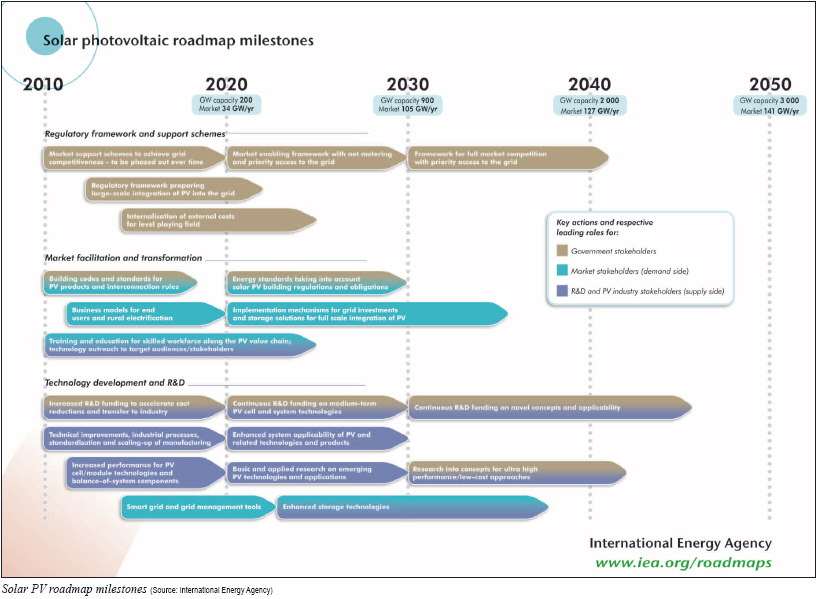By Suchitra Sriram
.jpg)
.jpg) Solar power is gaining widespread acceptance in several new markets globally as the preferred technology for distributed power generation because of its modularity and flexible usage. Over the last few years, the proportion of solar power in the global power generation mix has been steadily increasing because of solar energy credits and mandates, and improving economics of solar. As a result, the existing power transmission grid needs to be well equipped to receive PV power. Implementation of large-scale solar power plants faces significant challenges because of its integration with the power grid. Any form of solar power including rooftop Photovoltaic (PV), large PV arrays, or solar thermal plants are subject to intermittent power supply. This may cause fluctuations in voltage, power distribution loss, affects component performance, and decreases power quality. These factors put intense pressure on the utilities to maintain the power grid hardware. Upgrading the grid infrastructure is likely to ease out the challenges faced in integrating solar PV power. Solar power is gaining widespread acceptance in several new markets globally as the preferred technology for distributed power generation because of its modularity and flexible usage. Over the last few years, the proportion of solar power in the global power generation mix has been steadily increasing because of solar energy credits and mandates, and improving economics of solar. As a result, the existing power transmission grid needs to be well equipped to receive PV power. Implementation of large-scale solar power plants faces significant challenges because of its integration with the power grid. Any form of solar power including rooftop Photovoltaic (PV), large PV arrays, or solar thermal plants are subject to intermittent power supply. This may cause fluctuations in voltage, power distribution loss, affects component performance, and decreases power quality. These factors put intense pressure on the utilities to maintain the power grid hardware. Upgrading the grid infrastructure is likely to ease out the challenges faced in integrating solar PV power.
Integration of large-scale solar PV power plants and the smart grids would mandate the development of associated supporting technologies such as inverters, energy storage systems, and weather forecasting tools to offer smart grid functionality such as power monitoring and power conditioning. Moreover, the business case for adopting solar PV can be strengthened by the project developers if it is supported by smart grid solutions. Increasingly, utilities recognize that the implementation of smart grids will pave the way for the successful deployment of renewable energy projects as well as electric vehicles.
Challenges in Smart Grids and PV Integration
Highly Capital Intensive
Like solar PV projects, implementing smart grid infrastructure requires significant amount of capital. This, in turn, calls for favorable regulations and strong government support to provide funds. Improper planning in allocating funds for smart grid rollouts have cost a few of the smart meter companies dearly in the recent past.
Lack of Coordination between Industry Stakeholders
Integration of solar PV and smart grids require tremendous amount of continuous coordination and partnerships between the various industry stakeholders on a regular basis. At present, significant gaps between the various stakeholders hamper smart grid and PV integration. Educating the stakeholders about the potential benefits of working together to integrate these two technologies would address this challenge.

Low Performance of Supporting Technologies
Existing PV supporting technologies such as inverters are likely to be used to provide ancillary services especially to provide voltage/variance support for grid-connected solar PV systems. Presently, these features are lacking in the inverters and companies are still exploring options to introduce ‘smart’ inverters that are capable of integrating large-scale PV power into the smart grid with greater stability and better protection and control systems.
Utilities’ Cost Concerns
A wide majority of the utilities are highly concerned about the challenges in integrating intermittent power supply from solar PV with the smart grid. Areas of concern include voltage fluctuations, workers’ safety, and quality of power supplied. Despite availability of solutions to address these challenges, utilities find them highly expensive to adopt it. The utilities have to invest significantly to upgrade their traditional power T&D infrastructure, various distribution management systems, and internal processes. Besides, as smart grid technologies continue to evolve, utilities adopt a ‘wait and watch’ approach before they invest in them. This reduces their risk of managing outdated technologies and their continuous need to upgrade their systems.
Smart grid technology is expected to play a key role in the successful integration of solar PV with the utility grid as solar PV installations continue to double year-on-year due to falling costs and government mandates. Smart grid communication infrastructure is likely to react positively to variations in power supply and helps in maintaining grid stability.
The US Department of Energy (DOE) had initiated the Solar Energy Grid Integration System (SEGIS) project that brings together key industry stakeholders such as power utilities, grid operators, and leading companies in the PV, energy management and communications space to develop new products and technologies that facilitate smooth integration of PV power with the smart grid.
Integration of growing solar PV power with smart grids will usher in a new energy sector that would promote innovative business models that would deliver high value to end users.
Suchitra Sriram is Program Manager of Energy & Power System at Frost & Sullivan. Frost & Sullivan (www.frost.com), a global growth consulting company, has been partnering with clients to support the development of innovative strategies for more than 40 years. The company serves an extensive clientele that includes Global 1000 companies, emerging companies, and the investment community, by providing comprehensive industry coverage that reflects a unique global perspective and combines ongoing analysis of markets, technologies, econometrics, and demographics.
Frost & Sullivan is planning to publish a report titled ‘Renewable Energy Integration--Implications, Challenges and Opportunities’ in December, 2012.
For more information, please send your e-mails to pved@infothe.com.
ⓒ2011 www.interpv.net All rights reserved. |



